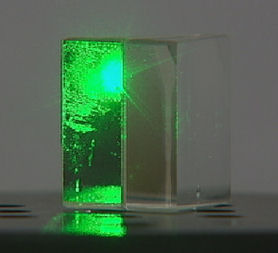‘Invisibility cloak’ is trick of physics, not magic
Scientists at Birmingham University have developed a device which can make small objects appear invisible. Tom Clarke visits them to see if science fiction has become science fact.

I’m watching a paper clip disappear behind Birmingham University‘s cloaking device. It’s very impressive – what looks like a transparent crystal makes the object totally vanish, writes Science Correspondent Tom Clarke.
It’s important science too. On the microscopic scale, and with weird forms of “light”, like microwaves, scientists have demonstrated cloaking before.
But what Dr Shuang Zhang and colleagues have shown is that you can make something that’s actually big enough to see disappear using visible light.
You can make something that’s actually big enough to see disappear using visible light.
What is more, they’ve done it using simple materials – in this case calcite crystal. But an “invisibility cloak” this is not. Sure, it can make small pieces of stationery appear to disappear but it requires some pretty strict criteria to work.
First, it only “hides” small objects lying flat on a surface. It also requires light to be polarised – so you can only see the effect through a filter. And because you can see the crystal that renders objects invisible, it is not like you can’t guess it is there.
But it is a demonstration of the principles of “cloaking” in the real world.
Dr Shuang Zhang, the lead scientist behind the breakthrough, told Channel 4 News that the findings could help future military research.
“You can hide something on the sea bed, such as a submarine, in the future,” he said.
“Of course, at the moment the size is too small. In the future you can scale things much bigger than this one, it could be used for these applications.”
Breakthrough
Like theories and nanoscale demonstrations before it, this breakthrough exploits the phenomenon of light refraction – the reason your shins look broken when you sit in the bath.
We “see” an object because light waves hit it and scatter off – some bouncing into our eyes, making the object visible.
Experimental invisibility cloaks work by bending light – like water around an object in a stream. Because light from the object doesn’t bounce back and hit our eyes, you get the illusion of invisibility.
Showing that a large calcite crystal can have that ability, however, could lead to advances in optics and in future optical computing.
Dr Paul Kinsler, of Imperial College London, said the discovery by the scientists in Birmingham was a big step forward.
“Very nicely and very simply, without using any complicated mathematics or very detailed pieces of engineering, they’ve shown you can have these cloaking effects to hide objects really with quite simple equipment,” he said.
-
Latest news
-
Windrush scandal: returning to the UK after a forty year wait6m

-
Netanyahu ‘survival’ depends on ‘expanding war’ says head of Palestinian National Initiative5m

-
Proposed law change could strip parental rights from paedophiles5m

-
Hugh Grant settles privacy lawsuit against The Sun newspaper publisher2m

-
Post Office Scandal: what did top executive know?6m

-




